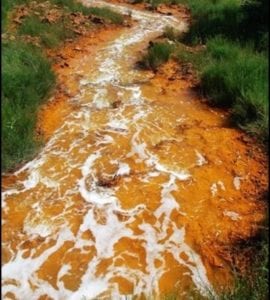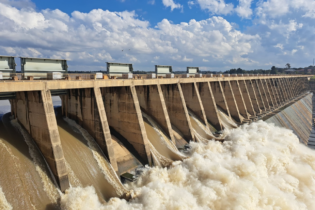The Emalahleni water reclamation plant in Witbank, Mpumalanga, which is currently undergoing a major expansion, serves as a “best practice” example of how a former liability – mine water – can be turned into a valuable resource – potable water – with extensive benefits for the community, the environment and its feeder collieries, Anglo Thermal Coalmanager: Hydrology, Thubendran Naidu, tells Chantelle Mattheus.
Approximately 130 million cubic metres of water is stored in Anglo Thermal Coal’s underground operations alone, with that figure projected to rise by almost 20 Mℓ/d. According to Naidu, Anglo Thermal Coal had originally treated mine water on its operations internally; however, the extent of the operations on all the then “satellite sites” resulted in significantly larger volumes of water that needed to be treated. Additionally, the vast impact of the water produced by the site has in part been due to the relevant roleplayers identifying a critical need locally, as the Emalahleni Local Municipality has long had supply and demand problems, which have been exacerbated in recent times with extensive industrial, commercial and residential expansion being experienced over the last decade. Historic context “The regulatory aspects with regards to compliance have also become much more stringent, so compliance to discharge of water quality standards is significantly higher than they were perhaps 10 years ago and we took the view then that we need to start to look at newer technologies that would assist us in more efficiently complying with these standards,” says Naidu. Over the years Anglo Thermal Coal investigated various technologies that were suitable; however, as Naidu notes some were not scalable, some were relatively immature and others weren’t compatiblefrom a lifecycle and cost perspective, when incorporating operating and maintenance costs. However, the need to treat the water was identified as a major immediate requirement – and the SACE (South African Coal Estates) complex was identified as the primary area for implementation of a large-scalewater treatment project, taking away the responsibility of water treatment from the three Anglo Thermal Coal mining operations in this locality, namely the Kleinkoppie Colliery, Greenside Colliery and Landau Colliery. “We were actually instrumental in developing the technology with Keyplan at the time and the project was approved in 2005 at a then value of R300 million. Today this would be the equivalent of approximately a R550 million investment. The project was implemented from early 2005 until October 2007 when we commissioned the first phase, treating 25 Mℓ/d of water from Greenside, Kleinkoppie and Landau,” says Naidu. Considered collaboration Naidu adds that over that same period Anglo Thermal Coal identified that treating the water on its own didn’t give the company the economy of scale it needed; hence it initiated discussions with BHP Billiton, which has a mining operation adjacent to Landau – the South Witbank Colliery. Following more than a decade of research and development, Anglo Thermal Coal then entered into a joint initiative with BHP Billiton Energy Coal South Africa (BECSA), which involved a 15% water input from its local sites, and a bulk supply agreement with the Emalahleni Local Municipality. The project is therefore a public-private partnership that has jointly been undertaken by Anglo Thermal Coal, BECSA and the Emalahleni Local Municipality, with the plant being wholly owned by Anglo American and contractor managed on its behalf by Aveng Water. Ensuring service delivery and supply Since 2007, the Reclamation Planthas been treating 25 Mℓ/d. It is at this time thatAnglo Thermal Coal also concluded a 20 Mℓ/d supply agreement with the Emalahleni Local Municipality, having identified initially in 2005 that the local municipality had a need for additional water. The local municipality has a licence for the Witbank Dam to abstract 75 Mℓ/d and itsdemand in 2005 was in excess of 100 Mℓ/d. “We approached the municipality on the basis that we are treating water that is suitable for discharge to the local reserve, which is the Noupoort Spruit that eventually feeds down into the Noupoort Dam and enquired whether it would be amenable to us supplying the water directly into the system,” explains Naidu. The supply agreement has since been amended to 16 Mℓ/d. “This is partly through demand side management on its side,” says Naidu, adding that the latest data shows a demand in excess of 130 Mℓ/d. “The local municipal treatment plant has a capacity of 75 Mℓ/d, although it is running it at 100 Mℓ/d. Supply is therefore still fairly constrained, so we still recognise that there is a need for additional water supply for the municipality,” states Naidu. Optimal operations To date the plant has over five years of operational and maintenance experience, with the team having ensured that water quality compliance is non-negotiable. “We run at full capacity. We implemented a mini upgrade in 2012 of another 5 Mℓ/d, so the current plant capacity is 30 Mℓ/d.In the five years we have operated the plant, there has never been a call to cut back. Looking back, the question of whether we needed the plant or not has been answered, so the investment decision has been well proven,” says Naidu.Part of the plant rationale for Anglo Thermal Coal was to take care – post-closure – of the water liabilities in the area, which remains a concern in the current acid mine drainage (AMD) context. Naidu states: “The plant is here to stay and the project still remains a critical factor because we recognise that AMD is something that tends to be a legacy issue if not managed up front and we certainly don’t want to be reactive when it comes to managing mine water.”
On the process itself, the mine water is fed into the dams and from there into neutralisation reactors where hydrated lime and limestone is used to neutralise the acidity, which varies across the mines that supply the water(between 3 000 and 20 mg/ℓ), and precipitate out any metals. “Naturally, the blended feed that comes in means the plant sees a lower acidity, which is part of the reason why we have multiple feed sources. The rationale is that from a quality point of view, you can blend your quality coming in so that we don’t have these spikes of quality better manage the volumes of water coming in to be treated,” explains Naidu. The mines are impacted by winter dry periods and summer rainfalls, so surface water management during summer rainfall is essential. Groundwater management during winter groundwater infiltration is an issue also that remains critical over that period. “So we have to flex the abstraction from the mines to allow themunicipality to manage that in-house, but that also allows us on the downstream side to make sure that we have sustained volumes,” says Naidu. The acid neutralisation that takes place in the primary neutralisation reactors results in a mix of liquids and solids, which is then settled out in clarifiers, with the clear water conveyed to the ultrafiltration and reverse osmosis processes. “Ultrafiltration removes the fine particulate matter and prepares the water for reverse osmosis.This is the desalting or desalination of the process that then gives us a permeate, which is our product – water.Werepeat that process train a second and a third time,” says Naidu, adding that each repetition recovers more water, ultimately getting to a 99.5% recovery. “To put that into perspective, as a benchmark, a typical seawater operates at a feed of TDS (total dissolved salt) of about 35 000 mg/ℓ. Our feed water is about 5 000 mg/ℓ, but a seawater desalination plant can only achieve a recovery of about 60% – so we have a large volume of brine that is generated and naturally goes back to the sea. Up inland we don’t have the sea so water recovery is absolutely essential. Driving to make sure that you minimise the final volume of brine that you produce is key to the success of this project.” The municipality’senergy footprint as well is exceptionally good, with the plant at about 3 to 3.5 MW/Mℓ treated. “The final quality control is that all three stages are blended into a final product that goes into disinfection – so we add chlorine and put back some salts through stabilisation and that goes into our final treatment reservoirs and then out to consumers. The same quality water – without stabilisation and disinfection – is suitable for discharge into river,” says Naidu. The brine gets stored on-site at a brine evaporation dam – the final disposal site for the brine. “Naturally, as part of the expansion, we won’t be producing any more brine. We will go from 0.5% brine to zero brine production through the selection of technology and blending of mine feeds. So we will never build another brine pond,” adds Naidu. Essential expansion On the success of phase 1, Anglo Thermal Coal continued to collaborate with itsmines on identifying and looking at their life of mine and closure requirements. “Through this we identified the Kromdraai section of Landau Colliery as an area that needed long-term water management to meet its closure requirements. As part of that, the Landau Colliery is embarking on an extension of its existing mining operations so there’s an immediate growing need for additional water management at Landau,” says Naidu. This in part led to the decision to increase the Emalahleni Water Reclamation Plant capacity in order to meet future demand and supply needs. The plant is currently undergoing expansion on-site that will double capacity from 25 to 50 Mℓ/d. The expansion commenced in September 2011, with commissioning scheduled for the end of the first quarter 2014. While Aveng is currently running Phase 1 and has secured the design and building contract for Phase 2, the operations contract for the expansion has not been concluded as yet. “As it stands, the intention is that the entire plant will continue to be contractor operated,” says Naidu. Currently, the expansion project is approximately 60% complete with the civil works scheduled for completion in March this year. January this year was scheduled for the commencement of the mechanical and electrical contracts for the treatment side of the plant itself. “We will then start commissioning from around mid-2013, which will take us to approximatelythe first quarter of 2014, because the nature of the plant is that have several phased commissioning’s.” Construction activities on-site are therefore fairly mature with relatively good performance on keeping to schedule and cost, with the project remaining on budget and on time, according to Naidu. “The investment is R730 million for the approved portion of the work – and we remain on track to meet that budgetary requirement.” One of the key things on-site has been safety, with the large team on-site. “At the moment about 300 people are on-site and we expect that once the project is complete we will have employed up to 600 people,” says Naidu. New network In conjunction with the expansion, Anglo Thermal Coal will also be embarking on the construction of the 23 km pipeline that brings water from Kromdraai to the site, with construction on this project having commenced in January and including pipes, pumping, control instrumentation and power supply. “What is important is that we have all the authorisation in place prior to commencing construction.The contract has also been awarded to WK Construction. We are still toproceed with contracts for the control instrumentation of the project – but that will only commence from mid-2013,” concludes Naidu.







